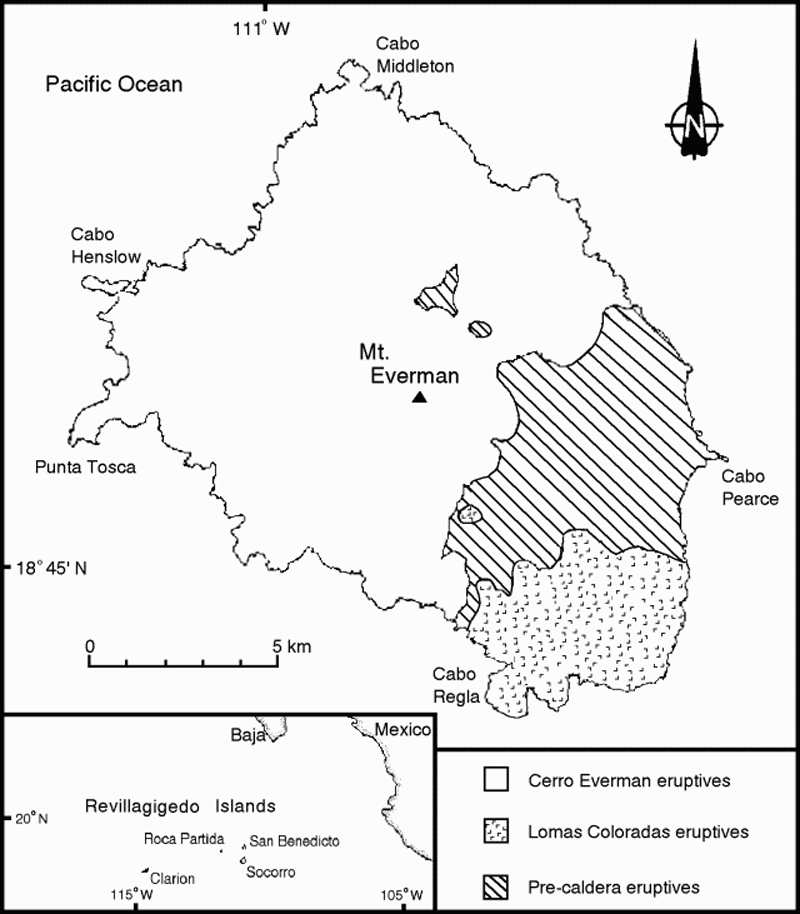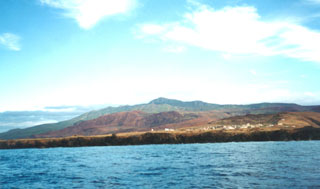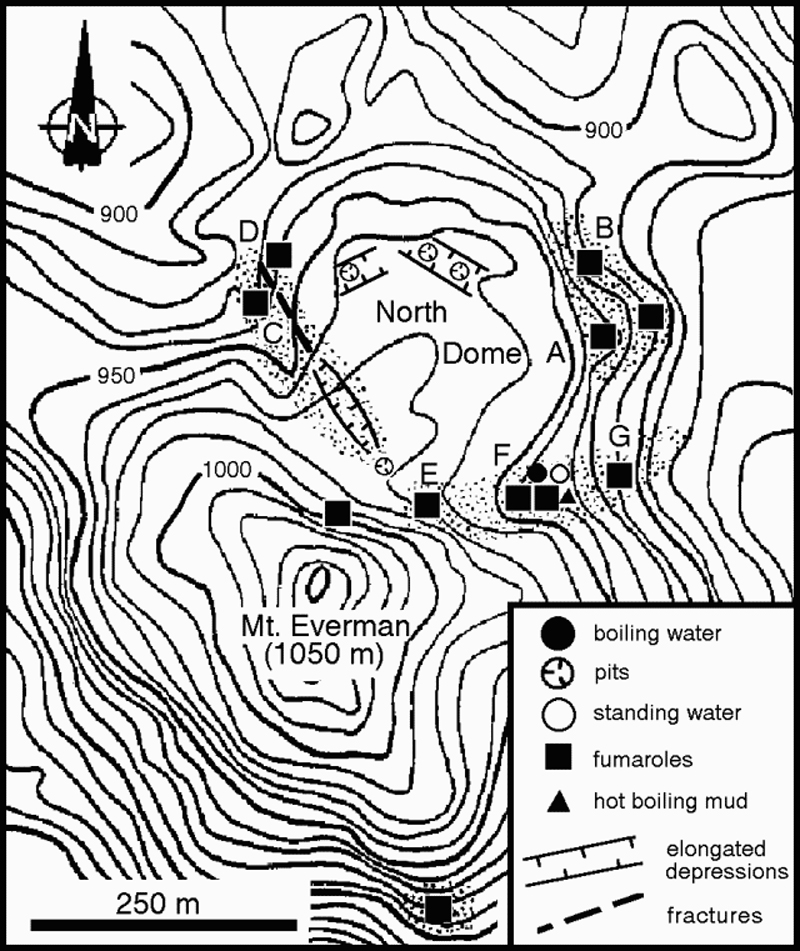Report on Socorro (Mexico) — January 1993
Bulletin of the Global Volcanism Network, vol. 18, no. 1 (January 1993)
Managing Editor: Lindsay McClelland.
Socorro (Mexico) Vesicular lava eruption from underwater vent W of the island
Please cite this report as:
Global Volcanism Program, 1993. Report on Socorro (Mexico) (McClelland, L., ed.). Bulletin of the Global Volcanism Network, 18:1. Smithsonian Institution. https://doi.org/10.5479/si.GVP.BGVN199301-341021
Socorro
Mexico
18.78°N, 110.95°W; summit elev. 1050 m
All times are local (unless otherwise noted)
Eruptive activity at Socorro Island (figure 1) was first observed at 1745 on 29 January 2.4 km NW of Punta Tosca (figure 2) by underwater photographers aboard the "Mystique." When the boat approached a steam column, they observed hot, dark-colored rocks ~1-3 m across breaking the surface in an area of ~50 m2. Depending on the specific block, there was production of hissing noises, steam, jets of white vapor several meters high, violent fracturing, or fragmentation that sent clasts to 50 m height. No explosive activity or volcanic plume was observed. Depending on vesicularity, blocks either sank or floated; floating rocks covered an area of ~6,000 m2 by 31 January. Depth soundings gave depths of 138-149 m in an area where a large number of gas bubbles were being generated, presumably by degassing of rising lava clasts. Activity had decreased by 3 February, when only eight blocks were seen at the surface, but the Mystique reported that activity fluctuated during the day and between days. Another depth sounding recorded a depth of 519 m.
 |
Figure 1. Location map and general geologic map of Socorro Island showing three major eruptive units (from Bryan, 1966 and 1976). |
 |
Figure 2. Sketch map and interpretive cross-section of the SW part of Socorro Island with location of submarine activity W of Punta Tosca. Courtesy of Ignacio Galindo. |
Juvenile material collected by Mystique divers is described by geologists as black to greenish, semi-translucent, highly vesiculated glass with vesicles up to 5-10 cm in diameter and abundant large (10-15 mm) gray tabular plagioclase phenocrysts.
Activity observed by geologists on 4 February (1245-1700) had a radius of about 1 km, centered at 18.81°N, 111.08°W, about 3.14 km from Punta Tosca and 4.63 km from Cape Henslow on Socorro Island. Water depth, determined by echo-sounding, was 80 m about 200 m SE from the most active area, and rapidly increased to more than 200 m travelling E towards the island. Although the data is only an approximation due to the difficulty of approaching the vent area, a sharp rise in the ocean-floor topography below the most active area is indicated. Very hot scoriaceous lava blocks, ranging in size from several centimeters to 2-3 m, were observed quickly rising to the surface and producing activity similar to that described earlier. Blocks then either floated away or sank, with some being propelled along the surface by steam and effervescence. The vent area was difficult to precisely locate because of strong wind and waves causing the blocks to drift. Most of the time, three distinct and separate areas were observed, somewhat aligned, where the majority of lava fragments were rising. Seawater temperature was normal, but a light sulfurous odor was detected. A helicopter inspection from 1815-1835 observed an accumulation of blocks below the surface from which large (up to 5 m) blocks detached and rose to the surface. Some type of spine from which blocks were being released was confirmed by an overflight about 15 m above the surface.
A helicopter reconnaissance flight the next day (1005-1059) observed activity similar to previous days. About 100 rocks could be seen at any one time during 20 minutes of overflight at 5-10 m above the surface, and there was a strong sulfurous odor. New fragments continuously rose to the surface with a trail of bubbles in two distinct areas about 100 m apart. Wind and waves again made it difficult to define the vent area. Elongated bands of fine gray solid matter floating on the surface, observed from higher altitudes, are interpreted as finely fragmented suspended scoria. There was no evidence of juvenile material accumulating close to the surface or above it. Another helicopter flight that afternoon did not observe any evidence of hot floating scoriaceous rocks. Reports from Naval personnel based on visual observations from the sea and air indicate continued submarine activity through 17 February, but no accumulation of material above the surface.
The summit fumarole area of Everman volcano on Socorro Island exhibited no unusual activity during a 5 February visit. The summit lava dome complex, composed of abundant obsidian and other less vitric lavas, did not contain any fumaroles. However, below the summit to the NNE and NW, there are fumaroles at the base of a relatively young lava dome (figure 3), which appears to be the most recent feature in the summit area. The younger dome, which has obsidian margins, appears to have filled an older crater in a depression about 100 m below the summit to the N. The most active area is on the SE side of the N dome along an apparent zone of weakness with cracks to 1 m deep and 1 m wide. This zone includes areas of vapor, boiling water or mud, clay alteration, sulfates, and sulfur encrustations. Temperature measurements were taken at the major fumaroles (table 1). The largest and most continuously active fumarole produced a hissing sound. Water samples from a hotspring near fumarole F were obtained for analysis. An older dome SE of the summit also has some very small fumaroles. Overall, vapor emissions in the summit area do not seem uncommon for an active volcano.
Table 1. Temperatures (°C) measured in fumaroles in the summit area of Everman volcano, Socorro Island. All temperatures are thermocouple readings, except for location D, which was measured with a calibrated mercury thermometer. Location F contained several fumaroles and associated hydrothermal phenomena.
| Date | A | B | C | D | E | F | G |
| 05 Feb 1993 | -- | -- | -- | -- | -- | 95-101 | 93-97 |
| 06 Feb 1993 | 77 | 76 | 75-84 | 61 | 74 | 73-75 | -- |
| 09 Feb 1993 | 83 | 80 | 77 | 62 | 80 | 75-77 | 76 |
| 12 Feb 1993 | 79 | 81 | 78 | 85 | 84 | 81-89 | 83 |
Precursors were first recorded on 19 January, when an unusual clustering of randomly distributed impulsive hydroacoustic signals (T-phases) was observed on recordings from SOFAR channel hydrophones located near the island of Oahu, Hawaii. The T-phases were accompanied by elevated levels of background noise. Activity intensified at about 1000 GMT, and lasted approximately 1 hour. Based on the strongest phases recorded in Hawaii and at the LDG in Tahiti, the source was located near Socorro Island. Seismicity was felt by Mexican naval authorities on the island beginning on 16 January. A portable MQ-800 seismometer was installed on 4 February at the naval base on the island.
Socorro Island is located ~716 km W of Manzanillo, Colima, and 480 km S of the tip of Baja California. Tectonically, it is located within a segment of the southernmost region of the East Pacific Rise, S of the Riverra Fracture Zone. Eruptions have been reported in 1848, 1896, 1905, and 22 May 1951, but there are no clear details about the eruptions or their effects. The island is a compositionally diverse volcanic complex that rises about 4,000 m from the surrounding ocean floor. Based on recent 40Ar/39Ar dating, the surface is estimated to be 540 Ka old. The youngest reported age, from a lava flow on the S side of the island, is about 15 Ka, but probably does not represent the youngest unit. There are about 60 men, stationed at the Mexican National Navy base, living on the island.
References. Bryan, W. B., 1966, History and mechanism of eruption of soda-rhyolite and alkali basalt, Socorro Island, Mexico: Bulletin of Volcanology, v. 29, p. 453-479.
Bryan, W. B., 1976, A basalt-pantellerite association from Isla Socorro, Islas Revillagigedo, Mexico, in Volcanoes and Tectonosphere, H. Aoki, and S. Iizuka, eds., p. 75-91.
Geological Summary. Socorro, the SE-most of the Revillagigedo Islands south of Baja California, is the summit of a massive, predominately submarine basaltic shield volcano capped by a largely buried, 4.5 x 3.8-km-wide summit caldera. A large tephra cone and lava dome complex, Cerro Evermann, forms the summit, and along with other cones and vents, fills much of the Pleistocene caldera. Rhyolitic lava domes have been constructed along flank rifts oriented to the N, W, and SE, and silicic lava flows from summit and flank vents have reached the coast and created an extremely irregular shoreline. Late-stage basaltic eruptions produced cones and flows near the coast. Only minor explosive activity, some of which is of uncertain validity, has occurred from flank vents in historical time dating back to the 19th century. In 1951 a brief phreatic eruption ejected blocks, and the gas column reached 1200 m altitude. A submarine eruption occurred during 1993-94 from a vent 3 km W of the island during which large scoriaceous blocks up to 5 m in size floated to the surface without associated explosive activity.
Information Contacts: Gustavo Calderón, Instituto de Oceanografía de Manzanillo, Las Brisas, Manzanillo, Colima, México; Ignacio Galindo, Carlos Navarro, and AbelCortés, CUICT, Univ de Colima, Apartado Postal 380, CP 2800, Colima, México; Jean-ChristopheKomorowski, ClausSiebe, and HugoDelgado, Instituto de Geofísica, UNAM, Coyoacán, 04510, México DF, México; BillChadwick, ChrisFox, and BobEmbley, NOAA, 2115 SE Osu Drive, Newport, OR 97365 USA; Charles S. McCreery and Daniel A. Walker, Univ of Hawaii at Manoa, Hawaii Institute of Geophysics, 2525 Correa Road, Honolulu, HI 96822 USA; J. Talandier, LDG Tahiti; Wendy Bohrson, Dept of Earth & Space Sciences, UCLA, 595 Circle Drive East, Geology Bldg., Room 3806, Los Angeles, CA 90024 USA; Bob Talbot and Charlie Peck, Bob Talbot Productions, P.O. Box 3126, Rancho Palos Verdes, CA 90274 USA.


